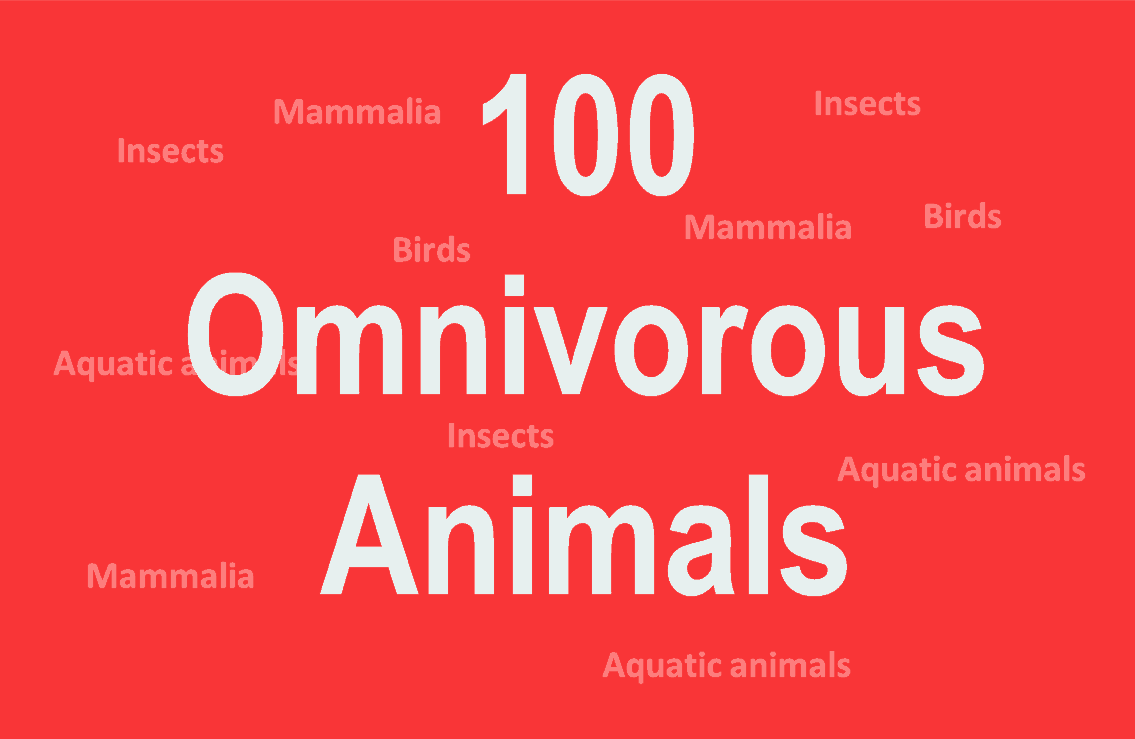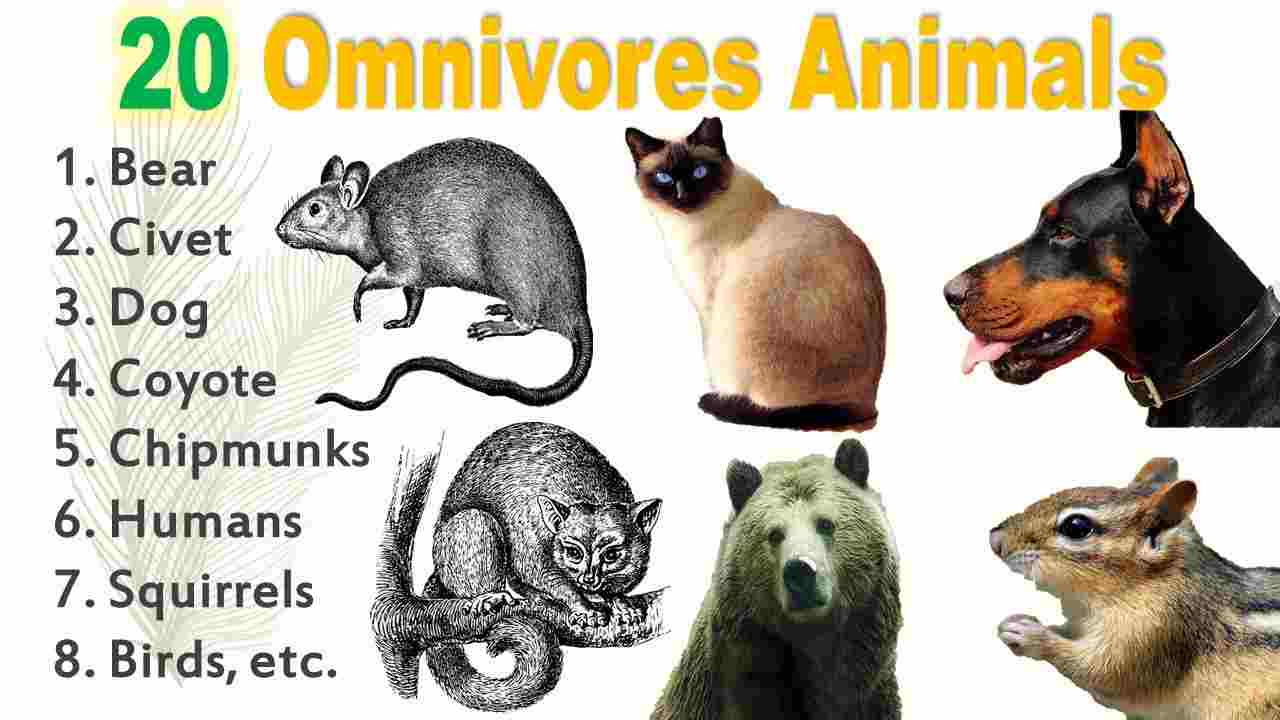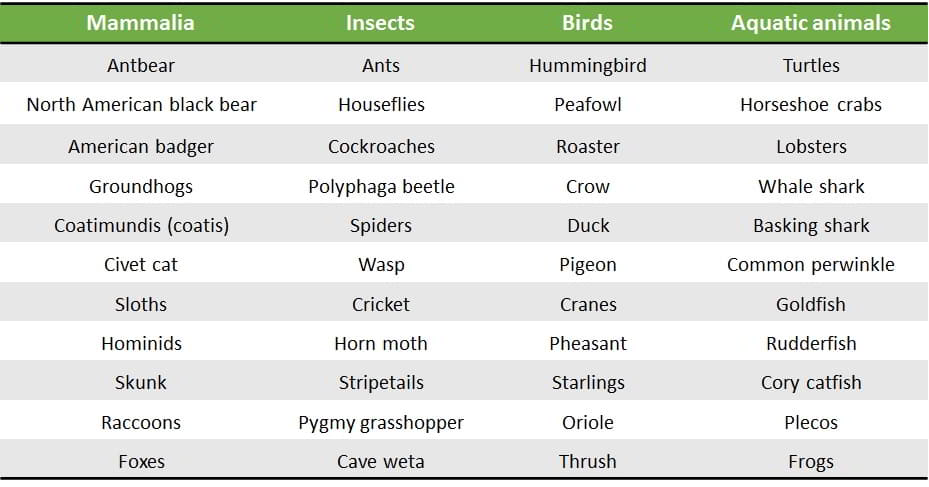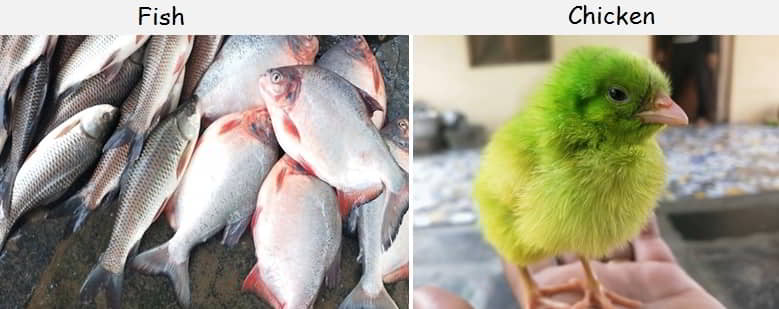Omnivores Definition
Omnivores are animals that have wider food options, and they can eat and digest food materials from both herbs and animals. Most living organisms belong to the omnivore category. Moreover, organisms from all types of tropical levels are the main food sources of omnivore animals. Omnivore animals can be found everywhere on the planet.
The size of omnivore animals ranges from small insects like ants to higher organisms like humans. You can find thorough information on this page, including the omnivore animals name list and their food sources.

List of omnivores animals and their food
Bear: Technically, bears are carnivores, but trophically, they are omnivores. That means they consume animals like insects, fish, small reptiles, etc.
Civet: It is essentially an omnivore that eats fruits, nuts, rambutan, chiku, and coffee, and also consumes insects and small animals.
Chipmunks: Chipmunks are also omnivores, meaning they eat different kinds of food materials. They aren’t restricted to specific tropical levels but consume what they get on their premises. They consume plant materials (fruits, nuts, and seeds) and animals, including baby mice, small birds, eggs of different birds, worms, and insects.
Coyote: It is an opportunistic omnivore that regularly eats wild animals and plants and typically eats whatever it gets. It hunts and scavenges small living creatures, ranging from small animals like mice to dogs.
Dog: Dogs are essentially omnivores, consuming food materials that are derived from both plants (grains and fruits) and animals (cats, rats, birds, etc.). Surprisingly, dogs eat grass and small plant leaves, especially wild dogs, which is quite common in most cases.
Human: Humans are the best examples of omnivore animals. Humans can hunt the animals and consume whatever they prefer to eat.
Hedgehog: Plant-derived materials like vegetables, fruits, and seeds, as well as animal-derived food materials like insects and other invertebrates, are the preferred food items for hedgehogs.
Monkeys: Monkeys also fall under the category of omnivorous animals, and they consume vegetables, seeds, fruits, nuts, and floral parts of plants. A few monkeys also eat animal-derived foods, especially eggs of birds, spiders, insects, and small reptiles.
Opossum: It is also known as a possum and eats dead animal matter, birds, rodents, frogs, eggs, and insects. It can also consume plant-based materials such as fruits and grains.
Pig: Pig is an omnivore and a foraging animal that majorly eats plant leaves, roots, fruits, and flowers. Moreover, it hunts small insects and fish.
Rat: A rat is an omnivore, that eats plant parts and small animals like insects, spiders, etc.
Squirrels: Most types of squirrels are omnivores, which means they prefer to eat both plant- and animal-based materials.
Birds: Omnivore birds eat both plant- and animal-based materials. Examples: Chicken, Duck, Sparrows, Crows, etc.
Fish: Omnivore fish eat both phytoplankton and zooplankton. Examples: Catfish, Parrotfish, Damselfish, etc.

Omnivorous mammals name list
| Mammalia | |||
| | Omnivore | Scientific Name | Main food |
1 | Antbear | Orycteropus afer | Ants, termites, and plant materials |
2 | North American black bear | Ursus americanus | Grass, roots, berries, succulent plants, meat, fish, insects, and larvae |
3 | American badger | Taxidea taxus | Insects, earthworms, prairie dogs, mice, ground-dwelling birds, and groundhogs |
4 | Groundhogs | Marmota monax | Insects, grubs, baby birds, variety of plants |
5 | Coatimundis (coatis) | Nasua nasua | Fruit, small rodents, lizards, and invertebrates |
6 | Civet cat | Civettictis civetta | Small snakes, small birds, insects, rats. Fruit include mangoes, chikus, bananas, etc. |
7 | Sloths | Folivora | Leaves, twigs and buds, flowers, fruits, and occasionally consume insects |
8 | Hominids | Hominidae | Fruit, bark, flowers, leaves, animals, insects, etc |
9 | Skunk | Mephitidae | Carrots, peas, apples corn, berries, pears, bananas, squash, small prey, snakes, beetles, grasshoppers cockroaches, crickets, spiders, fish, etc. |
10 | Raccoons | Procyon lotor | Fruits, seeds, nuts, insects, frogs, eggs, and crayfish |
11 | Foxes | Vulpes vulpes | Birds, rabbits, rodents, eggs, fruits, carrion |
Omnivorous insects name list
Insects | |||
Omnivore | Scientific Name | Main food | |
1 | Ants | Formicidae | The sap of plants and various fruits. Small living or dead invertebrates, milk of aphids, and other small Hemiptera. |
2 | Houseflies | Musca domestica | Carbohydrates, animal blood, etc. |
3 | Cockroaches | Blattodea | Decaying matter, meats, books, starches, sweets, hair, etc. |
4 | Polyphaga beetle | Polyphaga | Plants, dung, snails, pollen, insects, carcasses, small fish, tadpoles, snails, etc. |
5 | Spiders | Araneae | Eats pollen, worms, snails, and other insects. |
6 | Wasp | Vespidae | Larvae of insects, sugars |
7 | Cricket | Plant material and smaller insects | |
8 | Horn moth | Ceratophaga vastella | Larvae of insects, fruits, vegetables, etc. |
9 | Stripetails | Isoperla spp. | Leaves and animal matter |
10 | Pygmy Grasshopper | Tetrigidae | Eats leaves and sometimes animal tissue and animal faeces |
11 | Cave weta | Rhaphidophoridae | Plant products, fabric or cloth material, insects, and even fungus |
Omnivorous birds name list
Birds | |||
Omnivore | Scientific Name | Main food | |
1 | Hummingbird | Trochilidae | Nectar of flowers, small insects such as mosquitos, beetles, aphids, etc. |
2 | Peafowl | Pavo cristatus | Amphibians, eggs, reptiles, arthropods, insects, flowers, seed heads, nuts, etc. |
3 | Roaster | Gallus gallus | Nuts, grains, leaves, flower petals, lizards, insects, worms, etc. |
4 | Crow | Corvus | Grains, nuts, animal meat, birds, lizards, etc. |
5 | Duck | Anatidae | Insects, fish, worms, snails, weeds, seeds, etc. |
6 | Pigeon | Columbidae | Insects, worms, grains, seeds, etc. |
7 | Cranes | Gruidae | Grain, berries, fish, rodents, amphibians, insects, etc. |
8 | Pheasant | Phasianus colchicus | Grain, caterpillars, ants, earthworms, snails, beetles, crickets, etc. |
9 | Starlings | Sturnidae | Rice, vegetables, fruit, seed, worms, snails, insects, etc. |
10 | Oriole | Icterus | Grapes, oranges, nectar, insects, etc. |
11 | Thrush | Turdidae | Caterpillars, worms, snails, and fruit. |
Omnivorous aquatic animals name list
Aquatic animals | |||
Omnivore | Scientific Name | Main food | |
1 | Turtles | Testudines | Fruits, vegetables, and animal products |
2. | Horseshoe crabs | Limulidae | Algae, plants, small clams, crustaceans, and worms |
3 | Lobsters | Nephropidae | Plant products, worms, fish, mollusks, other crustaceans, etc. |
4 | Whale shark | Rhincodon typus | Plants and algae, small shrimp, fish, and plankton |
5 | Basking shark | Cetorhinus maximus | Plants and animal products |
6 | Common perwinkle | Littorina littorea | Algae and barnacle larvae |
7 | Goldfish | Carassius auratus | Plants, crustaceans, and insects |
8 | Rudderfish | Seriola zonata | Plankton, plants, algae, meat, etc. |
9 | Cory catfish | Corydoras | Algae rounds, shrimp pellets, tropical granules, and plant materials |
10 | Plecos | H. plecostomus | Plant debris, insects, small fishes, animal products |
11 | Frogs | Rana temporaria | Insects, worms, small fish, and algae. |
Related Topics
Other Biology Topics….
References:
- Jacqueline Boyd. 14 January 2020. Encyclopedia of Animal Cognition and Behavior: Omnivore. springer books.
- Kim, Soonok et al. “Comparison of carnivore, omnivore, and herbivore mammalian genomes with a new leopard assembly.” Genome biology vol. 17,1 211. 11 Oct. 2016, doi:10.1186/s13059-016-1071-4.
- Chubaty, Alex M et al. “On the evolution of omnivory in a community context.” Ecology and evolution vol. 4,3 (2014): 251-65. doi:10.1002/ece3.923.
- Pappas, Maria L et al. “Omnivore-herbivore interactions: thrips and whiteflies compete via the shared host plant.” Scientific reports vol. 8,1 3996. 5 Mar. 2018, doi:10.1038/s41598-018-22353-2.
- Root-Bernstein, Meredith, and Richard Ladle. “Ecology of a widespread large omnivore, Homo sapiens, and its impacts on ecosystem processes.” Ecology and evolution vol. 9,19 10874-10894. 11 Sep. 2019.












